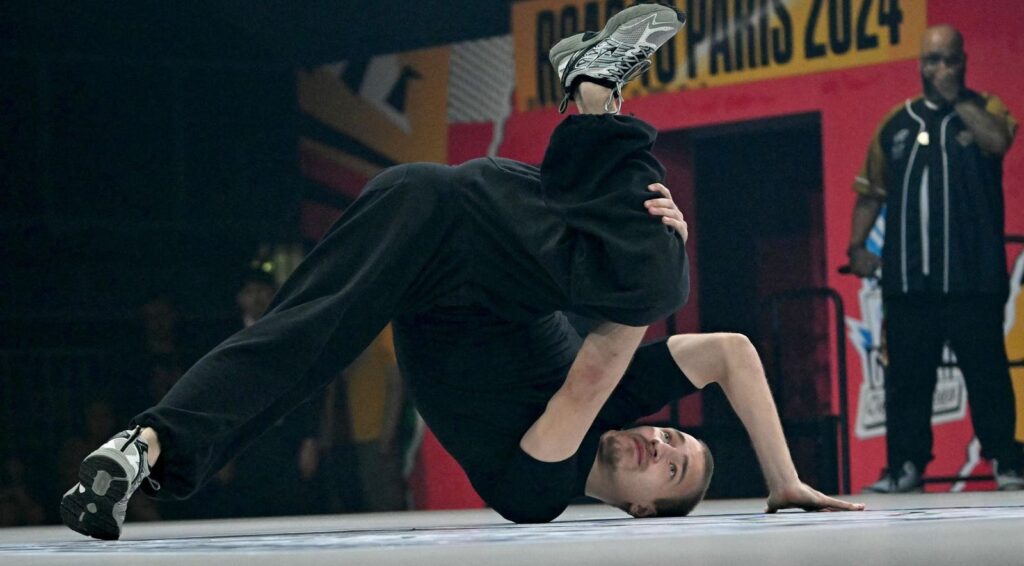Kazakhstan's Amir takes second place in Olympic Breaking B-Boys competition … [+]
The 2024 Paris Olympic Games are just a few weeks away, from July 26 to August 11. One exciting new addition to this summer's lineup is breaking, also known as breakdancing or b-boy/b-girl. Both an art form and a sport, breaking's energy and competitiveness make it a perfect fit for the Olympic stage.
Read on to find out more about what this new Olympic sport is, how it got started, and how breaking will feature in the Olympics.
Major features
Breaking, a dance style born out of counterculture and a need for self-expression, can be hard to define, but there are some distinctive characteristics that are instantly recognizable when watching breaking.
Top Rock, Footwork, Power Moves, Freeze
These are the four original elements of breaking that remain in the style today. Roughly speaking, top rock is performed primarily in an upright position and is usually used to start a round. Footwork consists of steps, sweeps and slides performed with the hands and feet on the ground. Power moves are usually rotational techniques where the breaker uses their hips and legs to gain momentum while supporting themselves with their upper body. Finally, freeze is a pose that is usually held at the end of a sequence.
music
Breaking is performed to a variety of musical genres, including funk, rock, jazz, and hip hop. A common thread is the breakbeat, a drum loop sampled from a musical “break.” Nowadays, DJs often play entire songs, not just drum loops. According to Steven Flegu, who DJed for the Budapest Olympic Qualification Series, there are no music licensing restrictions at the Olympics, so you're likely to hear more recent songs as well as classics from the '70s.
Improvisation
You might be surprised to hear that breakers don't know in advance what song will be played – only the DJ knows. Breakers prepare their move sequences in advance, but they must dance to the music in the moment. In fact, musicality is one of the Olympic judging criteria.
Breakdancing at the Roxy nightclub, West 18th Street, New York City, New York, circa 1880 … [+]
origin
Breaking's roots date back to the early 1970s in the Bronx, New York. Breaking emerged as one of the four elements of hip hop, along with DJing, MCing (rap) and graffiti. Like those elements, breaking emerged as a cultural and creative outlet in the midst of broader socio-economic hardship, and the movement was led by African-American and Latino youth.
No one could have imagined that breaking and hip hop would become a global phenomenon. 50 years ago, it was just for kids in basements. Now, 62 countries will participate in the WDSF Breaking World Championships in 2023, and 16 countries will compete in breaking at the 2024 Paris Championships. Obviously, the level of competition today is much tougher than it was in 1973.
PARIS, FRANCE – May 16: French B-Boy Mounir poses in front of the Arc de Triomphe … [+]
Entering the Olympics
Breaking was the first dance competition to be featured in the Olympics, but the format is similar to other sports. There are two competitions, B-Boy (men) and B-Girl (women), and the competition format is the same. During the competition, breakers compete one-on-one and take turns trying to win as many rounds as possible. A panel of judges votes after each round, and in the event of a tie in round wins, the breaker with the most judges' votes wins.
Each event will take place over a series of stages:
- Round Robin: 16 breakers will be split into 4 groups and will compete against all other breakers in their group. The top 2 from each group will be determined based on the number of rounds and the number of votes from the judges. These 8 will advance to the next stage.
- Quarter-finals and Semi-finals: 8 breakers will be seeded and compete in a single-elimination bracket. The battle will be a best-of-three, determined by rounds and judges' votes.
- Medal Battle: Breakers who lost in the semi-finals will battle for the bronze medal, while the winners will battle for the gold and silver medals.
The judging system equally evaluates five criteria: technique, vocabulary, execution, musicality, and originality. Because breaking has more freedom than other Olympic sports, the judging system is based on a comparison of the two breakers on stage, rather than a prescribed rubric score. Essentially, a breaker just needs to outdo their opponent to win the battle.
Breaking at the Paris 2024 Olympics will take place on August 9th and 10th at La Concorde, and will be broadcast live on NBC on E! (television) and Peacock (digital). Don't miss this exciting competition, where the best breakers in the world will bring the energy and athleticism of the sport to life.

